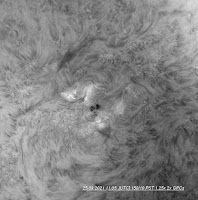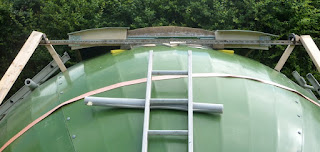*
Thursday 30th 48-56F. Wet morning, sunny later. Windy all day. Shopped for a discount tub of wedges.
I checked the new, smaller wedges but they were hopeless. Too thin, all over, and too short as well.
It looks as if I need to thin the yellow wedges locally. To avoid them pushing the brackets out too far. Ideally the wedges would be sanded to a radius, from midway up to the top, on the back. Except that side needs to grip the dome's CSM, layup surface as firmly as possible.
These wedges are slightly flexible. So might well follow the dome's gentle radius if I sanded the front. Where the shelf bracket will be pressing. The bottom of the bracket needs to be be firmly supported by the thickness of the yellow wedge. It is only higher up that the bracket is pushed outwards.I ought to offer up a sacrificial, older wedge to the disk sander. Just to see if I can reduce the bracket's overhang of the base ring. Yellow is a bit "loud" but I can always pretend they are high visibility. This might actually be useful in poor lighting.
Well, that was easy. A few seconds against the sanding disk and [only] the top edge was suitably thinner. I did it in stages to avoid overdoing the taper. The bracket was now in perfect contact, against the dome, from top to bottom. Now I have to buy lots more yellow wedges!
Knudsen also do a black wedge of identical size. However, they are only available in packs of 100. Do I care enough about appearance to waste money on barely seen wedges behind shelf brackets? Will I ever find a use for 70 extra wedges? Probably not.
Pressing the plywood base ring outwards, against the dome, is important. Otherwise a gap could appear before the brackets are safely screwed down onto the plywood ring.
Further screws could be driven downward at an angle. Into the dome's reinforcing rib between the brackets. This is best done after the brackets are all secured by the bolts and screws. The fiberglass rib is very sturdy from multiple layers of glass fiber. Which are laid up over the foam former.
Suitably large and long, stainless steel, self-tapping screws could get a really firm grip in this mass of GRP. Further reinforcing the base ring's location. Drilling pilot holes would be vital. To avoid these screws pushing the base ring off the dome's reinforcing rib. Or away from the inner surface of the dome.
Earlier, I was considering using long, fixing bolts rather than screws. Passing down through the 36mm thick ring and the 60mm deep rib but I'd need a very special drill. Just to be able to drill so close to the dome's overhanging curve. Most drill bodies are far too bulky. Trying to drill from underneath would require the entire dome be raised by a foot or more. Even that would need a long series drill bit and infinite patience.
Modern, parallel sided, "wood" screws should get a solid grip. Provided the pilot holes are the correct size. I don't think there is any need for patent fixing systems. Nor wall plugs. A final, generous bead of silicone sealer around the base ring, against the dome, will help to secure the base ring structure. While avoiding condensation from running behind the ring. Possibly causing long term damage.
*


















































